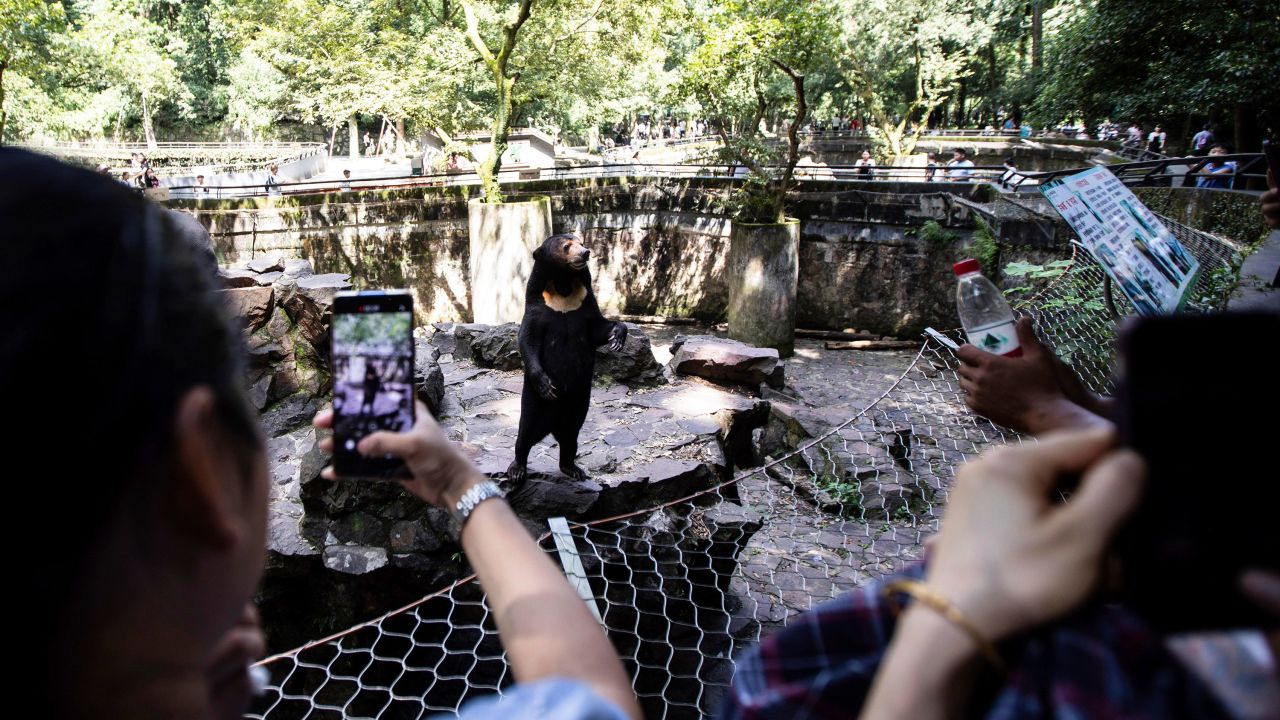Hong Kong
CNN
—
The world’s smallest bear is finally having its moment in the sun – thanks to a viral video that sparked a conspiracy theory on Chinese social media.
Public interest in sun bears, one of Asia’s most endangered and intriguing animals, has rocketed after video footage emerged showing a bear named Angela in her enclosure at the Hangzhou zoo in eastern China standing upright on a rock and waving her paw.
The video sparked a global debate about the bear’s uncannily human-like appearance, so much so that conspiracy theories began emerging that Angela was really a human dressed in a bear costume.
Experts have since debunked those theories, attributing the misunderstandings in part to the relative obscurity of the sun bear, whose numbers in the wild are thought to have dwindled to between 1,000 and 2,500, according to conservation groups.
Various wildlife conservationists told CNN that they now hope all the attention surrounding Angela will help to raise awareness about the sun bear’s plight – they face threats including deforestation and poaching for the illegal wildlife trade.
The bears are also commonly used in commercial bear bile farming – kept alive in tiny cages so their intestinal bile can be harvested and extracted in painful ways for use in traditional Chinese medicine.
“They are among the least known bears in the world – a forgotten species,” said wildlife biologist Wong Siew Te who founded the Bornean Sun Bear Conservation Center (BSBCC) in Sabah, Malaysia.
Wong has dedicated his life to researching, rescuing and rehabilitating sun bears and told CNN that he was encouraged to see “so much chatter and debate” about their behavior following the viral video.
“Sun bears are finally having their moment in the spotlight,” he said. “There is a lot to love about them which many people do not know about and they play important ecological roles. They are threatened by man and need more global attention and awareness to save the species.”
Since the videos of Angela spread across the internet, zoos in countries around the world have reported a wave of interest in the bears, which are native to Southeast Asia and named for the crescent shaped yellow, orange, amber or cream colored patches on their chests.
The Hangzhou zoo reported a 30 per cent surge in visitors to its sun bear enclosure following the videos, while an official at Taronga Zoo in Sydney, Australia, told CNN that it had been “all about sun bears” the past week.
Taronga zookeeper Logan Dudley said there had been an “uptick of people” this week showing interest in their resident sun bear Mary.
“They are a lesser known bear species… and are vulnerable and endangered,” she said. “With all the media attention surrounding the (sun bear videos) we have a good opportunity to further educate ourselves to save this species.”
Taronga Zoo is not alone. In a nod to the viral video, the Singapore Zoo shared footage of its own sun bears and confirmed they were “very real.”
Afiqah Nasir, a mother of two who visited Singapore Zoo on Friday, told CNN that the videos had amused her children and sparked their curiosity.
“We’re here because of that,” she said. “They now know that these are actual bears called sun bears and are not make believe, like people in T-rex costumes.”
Conservation director Bosco Chan at the World Wildlife Fund (WWF) in Hong Kong said that it was now “crucial to step up protection of sun bears in the wild” and stop the illegal trade of their body parts.
“Sun bears are extremely rare and close to extinction. Their forest habitats, where destruction by industrial agriculture such as oil palm and rubber plantations remains rampant, must be strictly protected,” Chan said.

Aside from being mistaken as people in costume, experts say sun bears are also sometimes mistaken as big dogs due to their size.
The bears, also sometimes known as the “honey bear,” stand about 28 inches tall and weigh between 55 lbs to 143 lbs.
This relatively compact size, for a bear, makes them a target of the illegal wildlife pet trade.
Cubs are especially cute and docile and can be easily tamed compared to bigger and more aggressive bears, said bear expert Dave Garshelis, chair of the IUCN SSC Bear Specialist Group.
“Poaching has escalated in recent years but sun bears are also threatened by the pet trade,” he said.
British colonial officer Thomas Stamford Raffles, who founded Singapore in 1819, is reputed to have kept a sun bear from Indonesia as a pet for two years, Garshelis noted.
A couple of centuries later and instances of people keeping the bears as pets continue to appear in media reports.
In 2019, a live sun bear was discovered in an apartment in Kuala Lumpur, Malaysia. It came to authorities’ attention after neighbors heard it whimpering and holding its paws out of the window. The owner claimed to have mistaken the bear “for a dog” and was fined $6,000 by a court.
Another woman was prosecuted for keeping a sun bear in her house in Singapore in 1993. She was fined $2,000 by the authorities and the animal was confiscated.

Garshelis has “mixed feelings” about the newfound fame of the sun bears. He fears it could encourage people to take them as pets and doubts it will lead to meaningful conservation efforts.
“All most people have learned is that sun bears often stand, have wrinkled skin and may even seem to wave their paws,” he said.
“In fact, it’s even possible that all this exposure has made people (consider them) as pets – there might be a small zoo somewhere looking to buy one to attract more visitors.”
“But they are a fascinating species,” he added.
“There’s so much more (to them) than standing and waving in a zoo.”